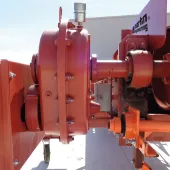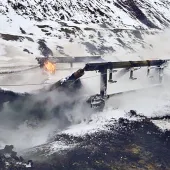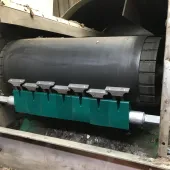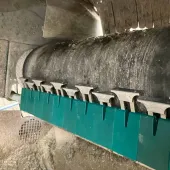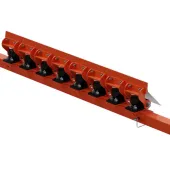Martin Engineering introduce STS belt cleaners

New Safe-to-Service belt cleaners help reduce risk and service time on heavy-duty conveyor systems
MARTIN Engineering have introduced a new family of heavy-duty conveyor belt cleaner designs that have been engineered so that the blade cartridge can be pulled away from the belt for safer access and replacement by a single worker.
Developed to secure both primary and secondary cleaners rigidly to the conveyor mainframe, the Safe-to-Service (STS) blades are initially available on the Martin QC1 HD and XHD primary cleaners, and the Martin SQC2S secondary cleaner.
‘Routine maintenance and replacement of blades that require reach-in or chute entry is an unpleasant and potentially dangerous task for workers,’ commented Daniel Marshall, product engineer with Martin Engineering. ‘We developed the STS system so operators could work on the product safely from outside the chute wall, without breaking the plane of entry.’
The system was originally developed for an international client who needed a safer method for workers to replace cleaner blades on a large conveyor system. After field-testing, operators found that the STS design reduced the risk of injury and required fewer workers to perform maintenance, contributing to greater overall process efficiency.
Made of rigid steel, the STS manifold is a circular mandrel fitted with a square shaft on which the blade cartridge is attached. Dual tensioners separately adjust either end of the patented constant angle radial pressure (CARP) blade on the primary cleaner and the cushioned reversible blade on the secondary cleaner, for a tight, consistent seal on the belt.
Designed for conveyor speeds up to 1,200 feet/min (6.1 metres/s) and belt widths from 18in to 120in (457mm to 3,048mm), the STS system is said to be well suited to heavy-duty applications in industries such as mining, quarrying and coal handling.
‘Part of innovation is not only better mechanical performance, but also improved workplace operations,’ said Mr Marshall. ‘We’ve found that, in our pursuit to engineer a safer component, efficiency naturally follows.’
The STS design eliminates many of the factors that expose workers to potential injury. To remove the blade cartridge, operators bring the conveyor to a full stop and make sure that no loose material is near the header.
Once the area is deemed safe, using appropriate lock-out/tag-out procedures, the blade cartridge is disengaged from the tensioner and pulled out far enough to remove the quick-release pin. The blade is then replaced, the pin reset, the rack pushed back into position and the tensioner re-engaged.
A single experienced maintenance technician can typically perform the replacement operation, resulting in a significant reduction in the total man-hours involved and allowing valuable labour to be deployed elsewhere.
‘Alhough the STS is currently geared toward heavy-duty conveyor systems, we’re working on expanding the technology to accommodate more of our product line,’ Mr Marshall revealed. ‘Our ultimate goal is to reduce and eventually eliminate reach-in and chute-entry injuries related to blade cleaning and maintenance.’




